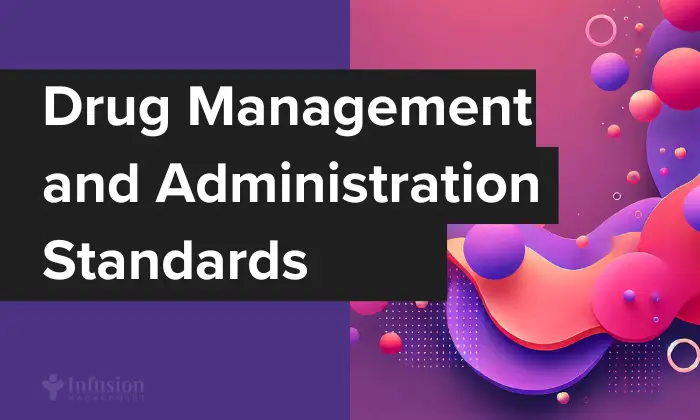Current standards in medical infusion therapy encompass comprehensive guidelines for safe drug administration across various healthcare settings. This report examines the established standards, administration methods, safety protocols, and setting-specific considerations essential for effective infusion management.
Governing Standards and Regulatory Frameworks
Infusion therapy practices are guided by several authoritative standards and organizations that establish evidence-based recommendations. The Infusion Therapy Standards of Practice, developed by the Infusion Nurses Society, provides foundational guidelines for infusion and access device-related care applicable across all healthcare settings 11. These standards undergo revision every three years, with the 2024 edition notably adding specific guidance for home infusion therapy 11.
The American Society of Health-System Pharmacists (ASHP) has implemented the Standardize 4 Safety initiative, which represents “the first national, interprofessional effort to standardize medication concentrations to reduce errors, especially during transitions of care” 14. This initiative addresses concentrations and dosing units for various administration routes, including intravenous continuous medications for adults and pediatric patients 14.
For infusion centers, the National Infusion Center Association (NICA) has established minimum standards to unify best practices, promote patient safety, and support industry growth 12. Additionally, The Joint Commission provides specific requirements for medication administration, particularly regarding titration orders used in infusion management 10.
Required Documentation Elements
The Joint Commission specifies essential elements for medication titration orders, which include:
- Medication name
- Medication route
- Initial or starting rate of infusion (dose/min)
- Incremental units for rate adjustments
- Frequency for incremental doses
- Maximum rate (dose) of infusion
- Objective clinical endpoint (e.g., RASS score, CAM score) 10
Infusion Methods and Administration Techniques
Medical infusion administration encompasses several distinct delivery methods, each appropriate for specific clinical scenarios:
IV Push (Direct Injection)
Also known as “IV push” or direct injection, this method involves administering medication directly into the vein, typically over a brief period4. This approach is suitable for situations requiring rapid medication delivery but must be administered carefully according to specific rate guidelines for each medication 13.
Intermittent Infusion
Administered over 20-120 minutes, intermittent infusions represent a compromise between bolus injections and continuous infusions 4. This method provides flexibility in medication delivery while reducing the risk of fluid overload compared to continuous methods.
Continuous Infusion
Continuous infusions deliver medications at a constant rate over extended periods, often 24 hours2. This method is particularly valuable for medications requiring stable blood concentrations and is commonly used for maintenance fluids, antibiotics, and certain cardiac medications 14.
Titration Infusions
These specialized infusions involve progressive adjustment of medication dosage in response to patient status 10. Titration requires detailed orders specifying not only the medication and initial rate but also parameters for adjustments and maximum dosages.
Fluid Types and Considerations
Intravenous fluids are categorized based on their solute concentration relative to blood:
- Isotonic fluids: Having similar concentration to blood solutes, these fluids (e.g., 0.9% normal saline) are primarily used for fluid and electrolyte replacement without causing osmotic fluid movement 2.
- Hypertonic fluids: With higher solute concentration than blood (e.g., dextrose 5% in 0.9% normal saline), these fluids are used in critical care situations to treat hyponatremia and help remove excess fluid through osmosis 2.
- Hypotonic fluids: Having lower solute concentration than blood (e.g., 0.45% normal saline), these solutions move fluids into cells through osmosis and are typically used for intracellular dehydration such as during diabetic ketoacidosis 2.
Safety Protocols and Error Prevention Strategies
Standardization Initiatives
The ASHP’s Standardize 4 Safety initiative addresses the critical need for standardizing medication concentrations 14. This program covers:
- Concentrations and dosing units for intravenous continuous medications
- Concentrations for compounded oral liquid medications
- Doses for oral liquid medications
- Concentrations for intravenous intermittent medications
- Concentrations for PCA and epidural medications 14
The program was developed through a multidisciplinary approach involving physicians, nurses, and pharmacists, with guiding principles prioritizing safety, operational considerations, and patient clinical needs 14.
ISMP Best Practices
The Institute for Safe Medication Practices (ISMP) has published its 2024-2025 Targeted Medication Safety Best Practices for Hospitals, which includes three new best practices:
- Utilizing point-of-care barcode-assisted medication safety checks prior to administering medications in surgical and obstetrical areas
- Using premixed intravenous bags of tranexamic acid when appropriate
- Separating or sequestering tranexamic acid in storage locations to prevent wrong-route errors 8
Infusion Pump Safety
The FDA’s Infusion Pump Improvement Initiative, launched in 2010, addresses persistent safety problems associated with infusion pumps through:
- Establishing additional requirements for manufacturers
- Proactively facilitating device improvements
- Increasing user awareness 5
This initiative recognizes that while infusion pumps provide “a high level of control, accuracy, and precision in drug delivery, thereby reducing medication errors,” they have also been “associated with persistent safety problems that can result in over- or under-infusion, and missed or delayed therapy” 5.
Equipment Standards and Selection
Infusion Pump Selection
The National Home Infusion Association (NHIA) has developed specific practice standards regarding “Electronic Mechanical Pump Selection for Home Administration of Infusion Medications” 6. These standards emphasize that “choosing the appropriate infusion method/device selection promotes safety, minimizes adverse drug reactions (ADRs) and therapy disruptions, avoid hospitalizations and emergency department use, and promotes adherence” 6.
Administration Sets and Filtration
Administration sets must meet specific requirements:
- Be appropriate for the product being administered
- Be compatible with infusion pumps if used
- Be dated to identify when they must be replaced 4
Replacement schedules for administration sets vary by type:
- Crystalloid/maintenance fluid: maximum 72 hours
- Total Parenteral Nutrition (TPN): normally 24 hours (some 48-hour bags)
- Antibiotics and ward-prepared drug infusions: 24 hours
- Blood, blood products, and colloid: immediately following use 4
Filtration is critical for certain therapies, particularly parenteral nutrition, to protect patients from harmful effects of particulate matter 16. Updated recommendations from ASPEN (American Society for Parenteral and Enteral Nutrition) advise using a 1.2-micron filter for all PN solutions, including those with lipids 16.
Setting-Specific Standards and Considerations
Hospital Infusion Management
Hospital infusion services must adhere to comprehensive policies and procedures addressing:
- Types of infusions to be administered
- Care and monitoring protocols for specific medications
- Safety procedures and adverse event management 3
Nursing responsibilities in hospital settings include:
- Administering infusions per provider orders
- Following policies based on professional standards
- Performing medication verification and inspecting medication integrity
- Providing insertion site care and monitoring
- Following established protocols for adverse events 3
Home Infusion Therapy
Home infusion therapy has gained specific attention in recent standards, with the 2024 Infusion Therapy Standards of Practice adding a dedicated section addressing this setting 11. For home administration, pumps can be programmed to:
- Deliver medication as a continuous infusion (steady rate over 24 hours)
- Deliver medication at specific intervals
- Maintain line patency between doses using “keep-vein-open” techniques (typically at 1 mL/hour) 15
Office-Based Infusion Centers
Best practices for in-office infusion centers emphasize:
- Clear and detailed procedures for preparation and administration
- Assessment and training of clinical personnel
- Maintaining adequate clinician-to-patient ratios
- Comprehensive patient assessment and informed consent processes 12
Office-based infusions require particular attention to staffing, patient scheduling, and treatment administration to ensure patient safety and satisfaction 12.
Documentation and Monitoring Requirements
Patient Monitoring
Proper patient monitoring during infusion is essential and includes:
- Assessing the IV site for patency when initiating new fluid or medication
- Aspirating for blood return and flushing the IV catheter according to policy
- Monitoring for signs of vein irritation or infiltration
- Regularly checking that the infusion is flowing at the prescribed rate 23
Documentation Standards
Documentation requirements for infusion therapy include:
- Complete records of the procedure and assessment findings
- Details of any abnormal or adverse events
- Information about the medication administered, including verification checks
- Signatures on additive labels for infusion bags 234
Summary
Drug management and administration standards in medical infusion therapy represent a comprehensive framework designed to ensure patient safety, medication efficacy, and standardized practices across healthcare settings. These standards continue to evolve through regular updates from professional organizations, reflecting the growing literature base and changing healthcare needs.
The transition toward standardized medication concentrations, improved safety protocols, and setting-specific guidelines demonstrates the healthcare industry’s commitment to reducing infusion-related errors and complications. As infusion technology advances and therapies become more complex, adherence to these evidence-based standards becomes increasingly important for healthcare providers across all practice settings.
Successful implementation of these standards requires ongoing education, competency assessment, and quality improvement initiatives to ensure that infusion therapy is delivered safely and effectively regardless of where care is provided.
References
- https://www.uspharmacist.com/article/infusion-therapy-standards-of-practice-for-home-care
- https://www.ncbi.nlm.nih.gov/books/NBK593209/
- https://www.health.ny.gov/professionals/protocols_and_guidelines/docs/checklist_for_infusion_therapy_services.pdf
- https://www.gloshospitals.nhs.uk/media/documents/IV_Drug_Administration_Resource_Booklet_VYD9bWc.pdf
- https://www.fda.gov/medical-devices/infusion-pumps/infusion-pump-improvement-initiative
- https://nhia.org/learn/practice-standards/
- https://www.hopkinsmedicine.org/-/media/compliance/documents/infusion-guideline-092020.pdf
- https://home.ecri.org/blogs/ismp-alerts-and-articles-library/three-new-best-practices-in-the-2024-2025-targeted-medication-safety-best-practices-for-hospitals
- https://store.rccsinc.com/products/2025-navigator%C2%AE-for-medical-oncology-hematology-and-infusion-centers
- https://www.jointcommission.org/standards/standard-faqs/critical-access-hospital/medication-management-mm/000002114/
- https://pubmed.ncbi.nlm.nih.gov/38975817/
- https://altusbiologics.com/best-practices-for-in-office-infusion-centers/
- https://hospitals.vchca.org/images/pharmacy_hca/20210916_100.025_IV_ADMINISTRATION_Guideline.pdf
- https://www.ashp.org/-/media/assets/pharmacy-practice/s4s/docs/Adult-Infusion-Standards.pdf
- https://pmc.ncbi.nlm.nih.gov/articles/PMC9757688/
- https://incativ.org/wp-content/uploads/2023/10/Infusion_Therapy_Standards_of_Practice_8th.1.pdf
- https://www.us.elsevierhealth.com/elseviers-2025-intravenous-medications-9780443120404.html
- http://www.bccancer.bc.ca/chemotherapy-protocols-site/Documents/Supportive%20Care/SCDRUGRX_Protocol.pdf
- https://www.cms.gov/files/document/11-chapter11-ncci-medicaid-policy-manual-2025finalcleanpdf.pdf



